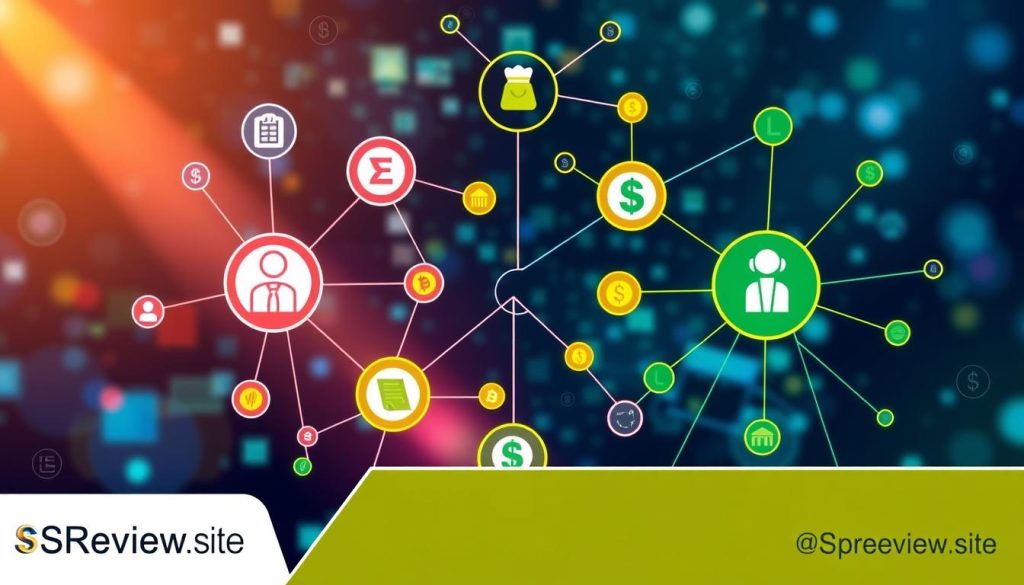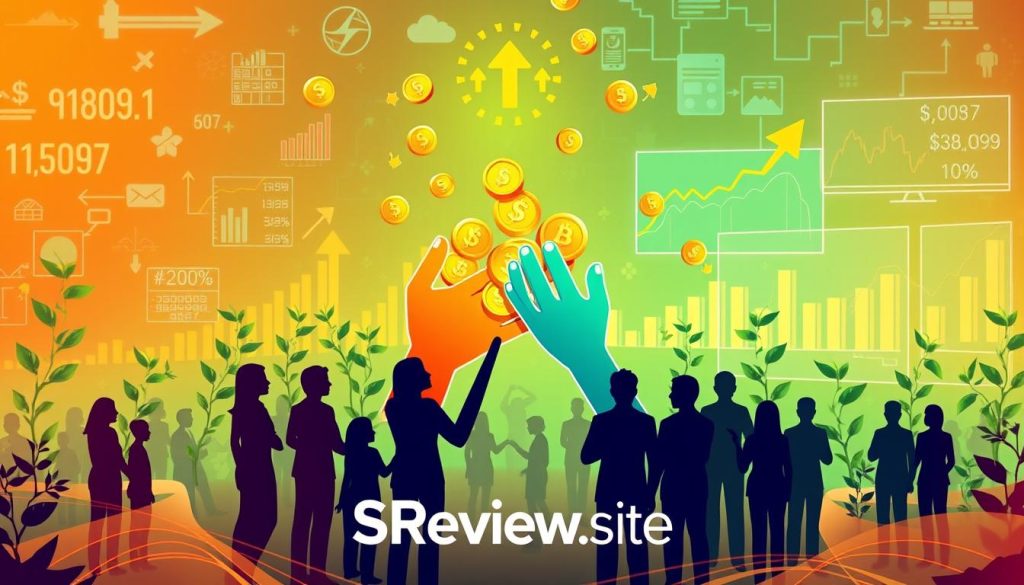Peer-to-peer (P2P) lending platforms have become more popular in recent years. They offer a new way to lend money, different from traditional methods. In this article, we’ll look at the good and bad sides of P2P lending platforms.
These platforms are known for giving borrowers low interest rates. At the same time, they offer investors a chance to earn more. As we dive into this topic, we’ll see how technology has helped make P2P lending more accessible. Knowing the pros and cons is key to understanding P2P lending.
Key Takeaways
- The growing popularity of peer-to-peer lending platforms reflects a significant shift in the lending landscape.
- Borrowers benefit from lower interest rates, while investors seek higher returns.
- An analysis of P2P lending platforms emphasizes the importance of understanding risks.
- Technology plays a critical role in making lending more accessible.
- Being informed about the pros and cons of peer-to-peer lending is essential for participants.
Understanding P2P Lending Platforms
Peer-to-peer lending platforms have changed how we get loans and invest in them. They connect borrowers directly with investors online. This way, we skip the middlemen, making loans easier and faster.
What are P2P Lending Platforms?
P2P lending platforms let people lend and borrow money without banks. Borrowers share their financial needs online. Investors look for loans that fit their goals. This method can offer lower rates for borrowers and better returns for investors.
Each platform has its own rules and terms. They’re designed to meet the needs of both lenders and borrowers.
The Evolution of Peer-to-Peer Lending
P2P lending started in the early 2000s with simple online systems. As the internet grew, so did the platforms. LendingClub and Prosper led the way to a more secure lending space.
Regulations helped these platforms grow. They became a key part of our financial world. Today, thanks to tech, more people can take part in lending.

| Platform | Year Established | Unique Features |
|---|---|---|
| LendingClub | 2007 | Personal loans, small business loans, credit card consolidation |
| Prosper | 2005 | Fixed-rate personal loans, flexible loan terms |
| Upstart | 2012 | Data-driven decisions using education and job history |
| Funding Circle | 2010 | Business loans, supports small businesses |
The Benefits of Peer-to-Peer Lending Platforms
Peer-to-peer lending platforms have many benefits for both borrowers and investors. These advantages help people make smart financial choices in this growing field.
Lower Interest Rates for Borrowers
Borrowers can get loans at lower interest rates through P2P platforms. Traditional banks have high costs, leading to higher rates for consumers. But, P2P platforms have less overhead, so they can offer better prices.
For instance, some platforms offer rates as low as 6%. This is much lower than the 12% or more at regular banks.
Higher Returns for Investors
Investors like P2P platforms because they can earn more than other investments. A savings account might give 0.05% interest. But, P2P investors can see returns of 8% to 12%.
This balance of risk and reward lets investors grow their portfolios. It’s a chance to find new growth opportunities.
| Type | Average Interest Rate for Borrowers | Average Return for Investors |
|---|---|---|
| Traditional Banks | 10-15% | 0.05-1% |
| Peer-to-Peer Platforms | 6-12% | 8-12% |

The Risks Involved in Peer-to-Peer Lending
Peer-to-peer lending comes with risks for both investors and borrowers. It’s important to understand these risks to make smart choices. We’ll look at default risks and how market changes affect these platforms.
Default Risks and Creditworthiness
One big risk in peer-to-peer lending is the chance of borrowers not paying back. It’s key to check how reliable a borrower is. Important things to look at include:
- Credit Scores: A high score means they’re more likely to pay back.
- Debt-to-Income Ratios: This shows how much debt they have compared to their income.
- Loan History: Past loan payments can show if they’re reliable.
If you don’t check these things well, you could lose money. This is a big drawback of peer-to-peer lending.
Market Fluctuations and Economic Factors
Changes in the economy and markets can really affect loans on these platforms. Things like job losses or economic downturns can make it harder for borrowers to pay back. Here are some examples:
| Year | Economic Condition | Default Rate |
|---|---|---|
| 2018 | Stable Economy | 2.5% |
| 2020 | Recession | 5.8% |
| 2021 | Recovery | 3.2% |
These examples show why it’s important to think about outside factors. Knowing these risks can help you make better financial decisions.
The Pros and Cons of Peer-to-Peer Lending Platforms
Peer-to-peer lending platforms have changed the financial world. They offer both good and bad sides for borrowers and investors. Knowing the pros and cons helps people make smart choices for their money.
Advantages of P2P Lending
One big plus of peer-to-peer lending is how easy it is to get started. Borrowers face a simpler application process with less paperwork than banks. They also get better interest rates, making it a great choice. Investors can earn more than with savings accounts or bonds. Some key benefits are:
- Direct connection between borrowers and lenders
- Opportunity for financial inclusion
- Flexible loan terms and amounts
Disadvantages and Challenges
But, there are downsides to consider. The rules for these platforms are not clear yet, which can be risky. Also, with so many platforms, competition is tough. This affects both borrowers and investors. Some major issues are:
- Risk of borrower defaults
- Lack of insurance on investments
- Potential for lower returns during economic downturns
Understanding the good and bad sides of peer-to-peer lending is key. It helps users make the best choice for their needs and goals. A detailed look at different platforms can help find the right one.
| Pros | Cons |
|---|---|
| Accessibility to funds | Regulatory uncertainties |
| Competitive interest rates | Market saturation |
| High returns for investors | Risk of defaults |
Comparing Different P2P Lending Platforms
In the fast-changing world of peer-to-peer lending, it’s key for both borrowers and investors to deeply analyze the different platforms. This review looks at well-known sites like Prosper, LendingClub, and Upstart. Each has its own special features, and knowing these can help users make smart financial choices that fit their goals.
Top Peer-to-Peer Lending Platforms Reviewed
Prosper is known for its easy-to-use interface and quick loan approvals. It offers a wide range of loan options. LendingClub is famous for its long history and strong investor protection, making it a top pick for stability. Upstart uses smart algorithms to judge creditworthiness, helping borrowers with different credit scores.
Together, these platforms give insights into fees, loan terms, and user experiences. This forms a detailed analysis of peer-to-peer lending platforms.
Criteria for Comparison
When comparing peer-to-peer lending platforms, several important factors come up. Ease of use is a big one, affecting how easy it is to navigate the site. The availability of services for both borrowers and investors is also key. Plus, competitive interest rates play a big role.
By considering these, users can make choices that match their financial goals. This detailed comparison helps readers understand the P2P lending world better.
FAQ
What are the main benefits of using peer-to-peer lending platforms?
Peer-to-peer lending platforms offer many benefits. They give borrowers lower interest rates because they save on costs. Investors can earn more than with traditional investments. They also help people get loans who might not get them from banks.
What are some possible drawbacks of peer-to-peer lending platforms?
There are some downsides. Borrowers might not pay back their loans, which is a big risk. Market changes can also affect lending. Plus, rules and regulations can be unclear, affecting both sides.
How do I assess the risks associated with P2P lending?
It’s key to check the credit scores and debt-to-income ratios of borrowers. Knowing about market trends and the economy helps predict risks. This way, you can make smarter choices on P2P platforms.
What should I consider when choosing a P2P lending platform?
Look at the fees, interest rates, and how easy it is to use the platform. Think about the services for both lenders and borrowers. Comparing these can help you pick the right platform for your goals.
How do peer-to-peer lending platforms compare to traditional banks?
P2P platforms often have better rates and quicker loans than banks. But, they come with risks like defaults and less regulation. It’s a trade-off to consider.
Are there specific P2P lending platforms that are recommended?
Yes, platforms like LendingClub, Prosper, and Upstart are popular. Each has its own features and user experience. It’s important to look at them closely to find the best fit for you.
Can I invest in P2P lending without significant financial knowledge?
You don’t need to be a finance expert. But, knowing a bit about credit risk and markets is helpful. Many platforms offer tools and resources for new investors.
Read Also: Student Loan Forgiveness Programs: Eligibility and Application Process




